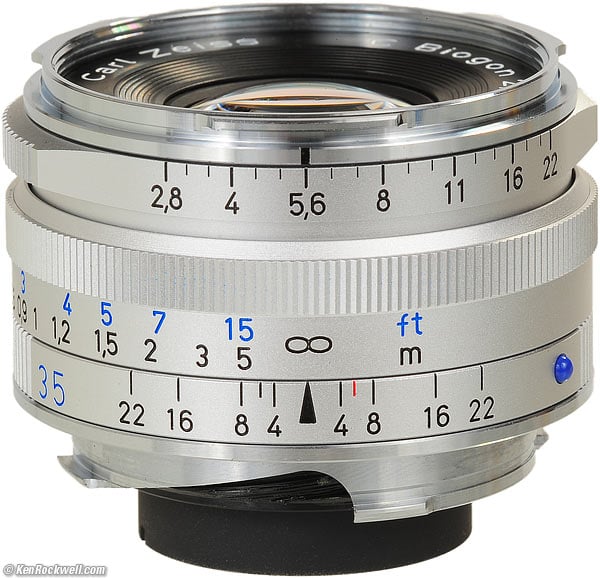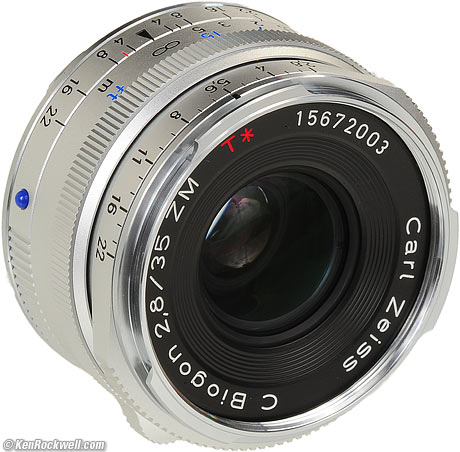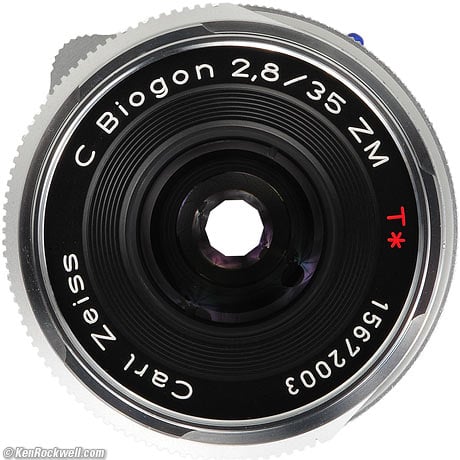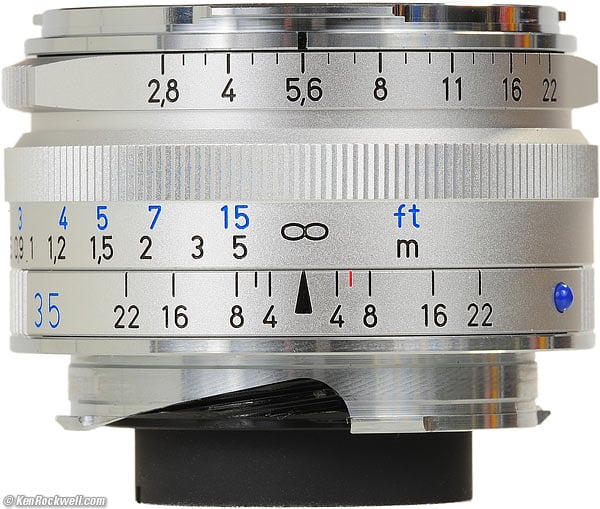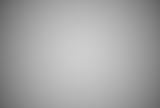Home Donate New Search Gallery Reviews How-To Books Links Workshops About Contact
Zeiss 35mm f/2.8
C Biogon T* ZM (for LEICA M, 2008-)
© 2011 KenRockwell.com. This page best with Corporate S regular and bold activated.
Intro Specs Performance Compared Recommendations
Zeiss 35mm f/2.8 C Biogon ZM in silver (43mm filters, 6.3 oz./178g, about $820, also comes in black). enlarge. This free website's biggest source of support is when you use these links, especially these directly to it at Adorama in silver or in black, or locally at OC Camera, when you get anything, regardless of the country in which you live. Here's the link to the optional hood. It helps me keep reviewing these specialized lenses when you get yours through these links, thanks! Ken.
February 2011 Zeiss Reviews LEICA LEICA Lenses Voigtländer All Reviews
Introduction top
Intro Specs Performance Compared Recommendations
|
I personally buy from Adorama, Amazon, Ritz, B&H, Calumet and J&R. I can't vouch for ads below.
|
The Zeiss 35mm f/2.8 C Biogon ZM is superb. Its optical performance is better than the LEICA SUMMICRON-M 35mm f/2 (1979-1996) and about the same as LEICA's newest LEICA SUMMICRON-M 35mm f/2 ASPH. In fact, this Zeiss is sharper than the LEICA SUMMICRON-M 35mm f/2 ASPH in the center, and this Zeiss also has much less distortion than the LEICA ASPH!
The biggest gotcha with this Zeiss lens is its incompatible 43 x 0.75mm filter thread, making it very difficult to use this lens as part of a system. You'll need to step it up to 46mm, or take your chances and step it down to 39mm to integrate into a LEICA system. Unless Zeiss is planning to introduce this lens in Nikon S mount that used 43 x 0.5mm filters, owning a lens with a one-of-a kind 43mm thread is a bad idea.
There are very good reasons that this f/2.8 Zeiss lens is better optically than LEICA lenses: it uses a more complex 7-element design. Most 35mm f/2.8 lenses make do with only 5 elements, LEICA used 6 elements, and today, with even better glass types and advances in design that could get the same performance with even fewer elements, Zeiss instead throws seven elements into this lens. Bravo! This lens is so sharp that it can excite aliases in the LEICA M9 wide-open.
Zeiss has been an annoyance to LEICA since the 1930s, and this lens only makes it tougher to justify paying more for a LEICA lens. If Zeiss put a 39mm filter thread on this, they would have cinched it from LEICA.
Zeiss 35/2 C Biogon ZM. enlarge.
Compatibility
Mount
This LEICA-M mount lens works perfectly on every LEICA M ever made, from the LEICA M3 of 1954 through today's LEICA M9.
It also works on every other LEICA M mount camera, like the Zeiss Ikon and those dirty little plastic Voigtländers.
LEICA lenses use 39mm filters, and sometimes 46mm filters for the larger lenses. This Zeiss takes 43mm filters, making it an odd lens to attempt to integrate into a practical system.
Metering
TTL meters in cameras like the CLE, Zeiss Ikon, Konica Hexar RF, LEICA M6, LEICA M6 TTL, LEICA M7, and LEICA M9 work fine with this lens.
Let's put this to rest right away.
Here are crops from the center of LEICA M9 DNG images at 100% as processed through Apple Aperture 3 at its default sharpening settings.
Printed full-image at this size, these would be about 52 x 35" (130 x 90cm) prints, at least as seen on most 100 DPI computer monitors:
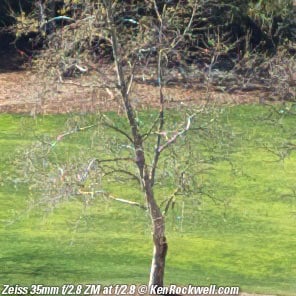 |
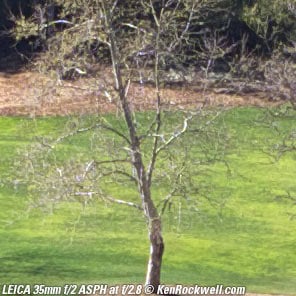 |
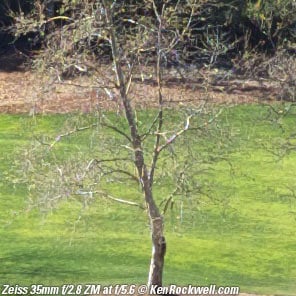 |
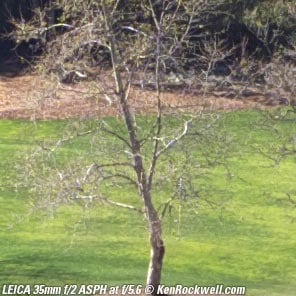 |
The slight color blips on the branches are aliases, which are caused when the image formed on the sensor is so sharp at a light section is so small that it hits only single pixels at a time. The system creates a funny color, the alias, because by hitting only one CCD well, it is interpreted as being the color detected by that single well. The more color blips you see, the sharper the image.
Not only is this Zeiss sharper than LEICA's SUMMICRON-M ASPH in the center, we've even given the SUMMICRON-M ASPH a one-stop head start by shooting it at f/2.8, not wide-open at f/2. The LEICA SUMMICRON-M ASPH was released on 1996, 12 years before this new Zeiss 35mm f/2.8.
Specifications top
Intro Specs Performance Compared Recommendations
Name
Zeiss calls this the Carl Zeiss C Biogon 2/35 ZM T*.
C means compact.
Biogon is Zeiss' trademark for reasonably symmetrical wide-angle lenses.
ZM means LEICA M mount.
T* is Zeiss' trademark for their multicoating.
Optics top
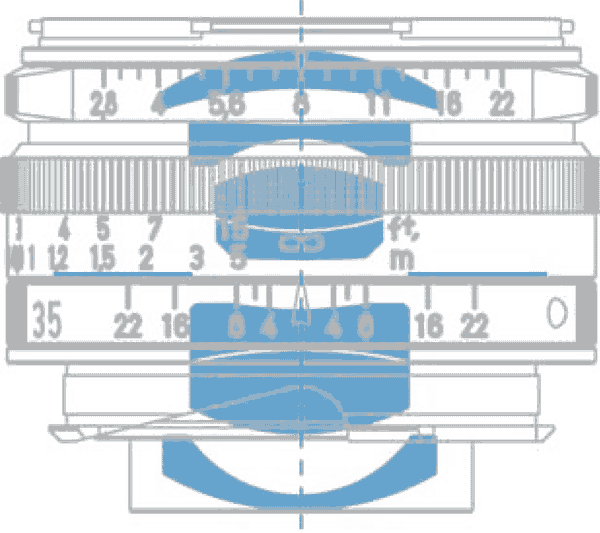
Internal Diagram, Zeiss 35mm f/2.8 ZM.
7 elements in 5 groups.
T* is Zeiss' trademark for their multicoating.
Diaphragm top
Front, Zeiss ZM 35mm f/2.8 at f/5.6. enlarge.
10 straight blades.
Stops down to f/22.
Third-stop clicks.
Angle of View top
38º by 53º (62º diagonally).
Actual Focal Length top
The actual focal length is a little longer than the LEICA 35mm SUMMICRONs, and also longer than the Zeiss 35mm f/2 ZM, against which I compared it. This lens' angle of view is slightly more narrow than these other lenses.
Zeiss confirms this by this lens' narrower angle-of-view specification. Zeiss specifies 38º by 54º (65º diagonally) for the 35mm f/2 ZM, for instance.
Close Focus top
0.7 meters (2.3 feet).
Maximum Reproduction Ratio top
1:18.
Area covered: 13 x 62 cm (16 x 24"), rated.
Size top
2.034" (51.7mm) diameter by 1.173" (29.80mm) extension from flange, measured.
Weight top
6.279 oz. (178.0g), measured.
7.1 oz. (200g), specified.
Hood top
The precision metal hood (part nr. 1365-667) isn't included, which is too bad, since it's very nice.
It sells for about $85 at Adorama.
This Zeiss hood bayonets and locks. The only way to get it off is by firmly pushing it towards the camera to unlock and then rotating. It is spring loaded so it will never fall off, unlike LEICA hoods.
Introduced top
19 March 2008.
Part Numbers top
Black Lens: 1486-393.
Silver Lens: 1486-394.
Hood: 1365-667.
Scope of Delivery top
You only get the lens, caps and fancy paperwork.
The hood is $85 extra.
Made in top
Japan.
Performance top
Intro Specs Performance Compared Recommendations
Overall Bokeh Color Diaphragm Calibration Distortion Ergonomics
Falloff Filters Finder Blockage Focus Lateral Color Fringes
Materials & Construction Sharpness Sunstars
Overall performance top
The Zeiss 35mm f/2.8 ZM is optically as good or better than any 35mm LEICA SUMMICRON.
The worst thing about this incredible Zeiss C Biogon is its idiotic 43mm filter thread. Who wants to carry a second complete set of 43mm filters to support this lens?
Bokeh performance top
Bokeh, the character of out of focus backgrounds, not simply how far out of focus they are, is a little better than average. It's about the same to a bit better than the LEICA SUMMICRON-M 35mm f/2 (1979-1996) and LEICA SUMMICRON-M 35mm f/2 ASPH to which I compared it directly.
Bokeh doesn't matter much with 35mm f/2.8 lenses simply because nothing is ever far out of focus with a slow, wide-angle lens. Since bokeh deals with the look of out-of-focus areas, and there is rarely anything much out of focus with this lens, bokeh is largely irrelevant, unlike with fast, long lenses.
Here are crops from the center of 100% LEICA M9 images, focused on a reference phase lattice at 3 meters (10 feet) with synthetic reference vegetation at 15 meters (50 feet). Printed full-image at this size, these would be about 52 x 35" (130 x 90cm) prints, at least as seen on most 100 DPI computer monitors:
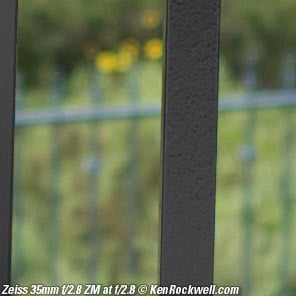 |
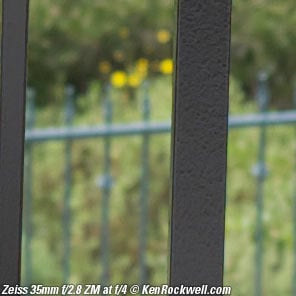 |
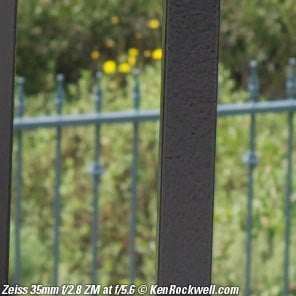 |
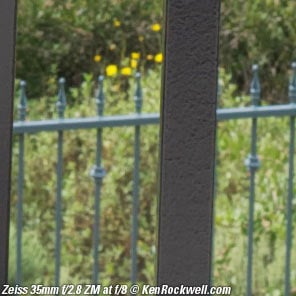 |
Color Balance performance top
The color balance of this Zeiss is neutral.
By comparison, the LEICA SUMMICRON-M 35mm f/2 ASPH is a little more red, and the LEICA SUMMICRON-M 35mm f/2 is a little more green.
Diaphragm Calibration performance top
The calibration is right-on: the meter in my M9 tracks each full-stop perfectly throughout the entire range, except of course at the largest aperture.
Distortion performance top
The Zeiss ZM 35/2.8 has no visible distortion.
What little there is can be corrected for more critical use by using a factor of -0.8 in Photoshop's lens distortion filter. This will correct the invisible pincushion distortion at 3 meters.
Claimed Distortion, percent, at infinity
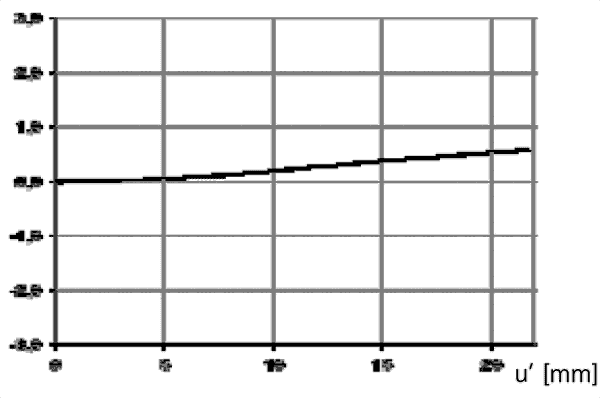 Distortion, Zeiss 35mm f/2.8 ZM. (one-percent vertical divisions.)
Distortion, Zeiss 35mm f/2.8 ZM. (one-percent vertical divisions.)
Ergonomics performance top
Zeiss ZM 35mm f/2.8. enlarge.
Ergonomics are great, except for the stupid filter size.
The numbers and their indices are easy to read in any light, except that the red footage markings on the black version are invisible in anything other than daylight. They are much clearer in these pictures than they are in practice. The silver lens is always easy to read.
Focus is silky-smooth, has no play, and slides with a fingertip. There is a raised metal nubbin on the bottom to help you focus with just one finger, as well as be able to set distance by feel in the dark.
The aperture ring also flicks with a fingertip. It has a detents at third stops, and the full stops aren't more deeply detented, so if you count clicks as I do, it can become confusing if you shoot LEICA lenses at the same time.
Falloff (darker corners) performance top
Falloff is visible at f/2.8 on a LEICA M9, and goes away at smaller apertures.
I've exaggerated this here, showing gray field shots against gray.
In the LEICA M9, there is no lens profile for this Zeiss lens. It works fine with any of the LEICA 35mm profiles, or with none at all.
These samples were shot with no lens profile, and then with the LEICA SUMMICRON-M 35mm f/2 11 310, 11 311 profile. Set different profiles and you'll get different results.
Zeiss ZM 35mm f/2.8 falloff on full-frame M9 at infinity, no profile:
© 2011 KenRockwell.com. All rights reserved.
Zeiss ZM 35mm f/2.8 falloff on full-frame M9 at infinity, 35/2 11310 profile:
© 2011 KenRockwell.com. All rights reserved.
|
Zeiss' claimed falloff performance:
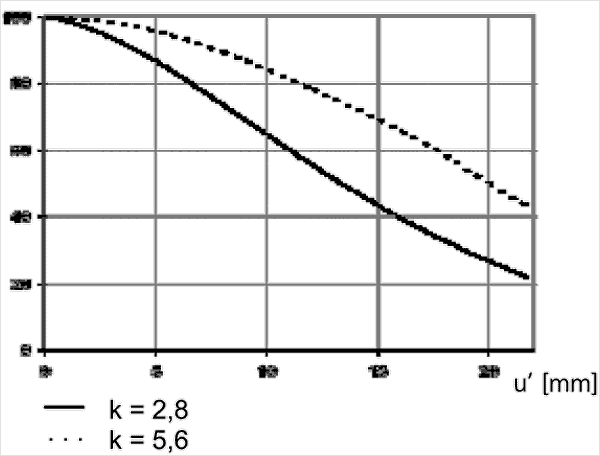 Relative Illuminance, percent, from Zeiss.
Relative Illuminance, percent, from Zeiss.
Filters, use with performance top
43mm filters? Zeiss has got to be kidding. This is a serious drawback for serious use as part of a larger LEICA system: no LEICA lenses take 43mm filters, so with this lens, you've committed yourself to having to carry a duplicate set of 43mm filters.
Any 43mm filter (0.75mm thread pitch) works great, with no vignetting. It works great with thick rotating filters, too.
Sadly, 43mm is a unique filter size. No LEICA lens uses 43mm filters. Nikon's rangefinder lenses of the 1940s and 1950s often used 43 x 0.5mm filters, but since this lens doesn't come in Nikon S mount, this incompatible filter size is this lens' biggest drawback: you'll have to pack a second complete set of filters just for this Zeiss lens.
You can step it up to 46mm to be compatible with LEICA's larger lenses, but then you can no longer use Zeiss' hood, and you'll get more finder blockage.
It probably works fine if you could find a 43mm -> 39mm step-down ring, but I couldn't. 43mm filters are much larger than this lens needs.
Finder Blockage performance top
There is almost no finder blockage at long distances, and just a little at close distances. I wouldn't worry about it. This is without a hood; add a hood, and you'll see its cutout in your finder.
Focus performance top
Focus is smooth. It's easy to move with a fingertip.
Focus accuracy was perfect on a LEICA M9 at f/2.8.
With rangefinder cameras, if you get too picky, you'll never be happy. They all vary a little from sample to sample, but this is rarely, if ever a problem with 35mm lenses.
Lateral Color Fringes performance top
There are no color fringes as used on a LEICA M9.
Materials and Construction performance top
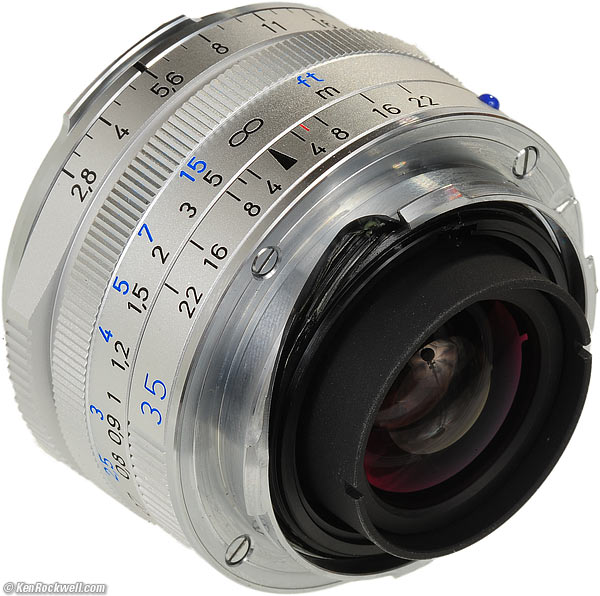
Rear, Zeiss ZM C Biogon 35mm f/2.8. enlarge.
This Zeiss 35/2.8 ZM is very well made. Leica has economized recently by using plastic for its focus tabs, while this Zeiss still uses solid metal for everything.
Filter threads and hood mount
Seem like chromed brass.
Barrels, aperture and focus rings
Seem like aluminum.
Finish
Matte silver anodized or semi-gloss black enamel.
Focus helicoids
Seem like brass.
Mount
Seems like chromed brass.
Markings
Engraved and filled with paint.
Blue index dot
Plastic.
Sharpness performance top
The more you know about photography, the more you know that lens sharpness doesn't matter.
This said, this Zeiss 35mm f/2.8 C Biogon is among the sharpest 35mm lenses ever made. I've never used a sharper 35mm lens. Differences between this lens and the LEICA SUMMICRON-M 35mm f/2 ASPH is where in the image one lens is sharper than the other, not any overall supremacy over all conditions.
The current LEICA SUMMICRON-M 35mm f/2 ASPH is sometimes just a little sharper on the sides and corners, while this Zeiss is sharper than the LEICA lens in the center, so I'll call it even — or a win for this Zeiss.
This Zeiss f/2.8 lens is slightly sharper in the corners than the Zeiss 35mm f/2 ZM.
As tested on a LEICA M9 at infinity in DNG
f/2.8
This Zeiss is already so sharp at f/2.8 in the center that it can excite aliasing on an M9!
The corners are just a tiny bit softer, as they are with the LEICA SUMMICRON-M 35mm f/2 ASPH.
The Zeiss is sharper in the center than the LEICA SUMMICRON-M 35mm f/2 ASPH, while the LEICA ASPH is a bit sharper in the corners.
f/4
The center is ridiculously sharp, much sharper than even the LEICA ASPH.
The corners are a little softer. The LEICA ASPH has slightly sharper corners.
f/5.6
The center is sharper than the LEICA ASPH.
The corners are almost as sharp.
f/8
The center is ever so slightly dulled from diffraction.
The corners are a little better than at f/5.6.
f/11 - f/22
Performance is limited by diffraction.
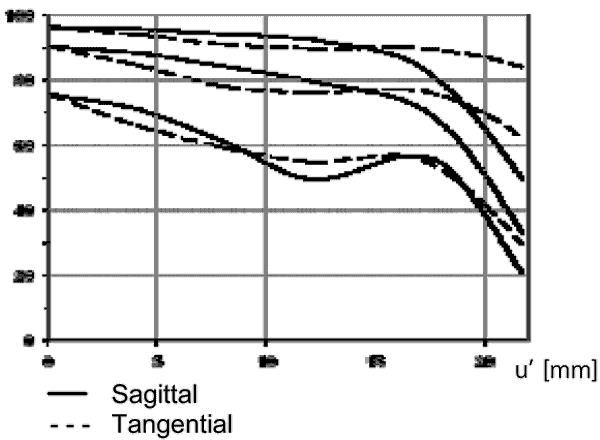
Zeiss's MTF curve for the 35mm f/2.8 ZM at f/2.8 (white light, 10, 20 ü. 40 c/mm).
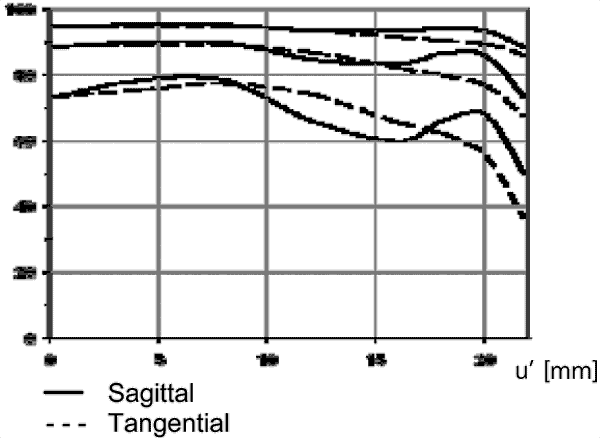
Zeiss's MTF curve for the 35mm f/2.8 ZM at f/5.6 (white light, 10, 20 ü. 40 c/mm).
Sunstars performance top
With a straight 10-bladed diaphragm, the Zeiss 35/2 should make 10-pointed sunstars on brilliant points of light.
Compared top
Intro Specs Performance Compared Recommendations
I've been making comparisons throughout this review, especially my sharpness comparison above.
This Zeiss 35mm f/2.8 ZM is as good, or better, optically than any LEICA SUMMICRON 35mm f/2, however this Zeiss' ergonomics are inferior due to a queer filter size.
Central sharpness is the same as the Zeiss 35mm f/2 ZM, corner sharpness in this f/2.8 lens is better than the f/2 version. Distortion is slightly higher in this f/2.8 version, but still invisible.
LEICA stopped making 35mm f/2.8 lenses in 1974, thus I haven't mentioned them before in this review. The LEICA SUMMARON 35/2.8 (1958-1974) is much softer in the corners at larger apertures, getting sharp stopped down. The advantage of the SUMMARON is taking a proper sized filter, and that it's very sharp stopped down where these lenses are usually shot anyway.
| Dates | 2008- |
1958-1974 |
2004- |
1996- |
1979-1996 |
| Filter | 43mm |
39mm |
43mm |
39mm |
39mm |
| Length | 29.8mm |
29.0mm |
43mm |
34.5mm |
26.4mm |
| Finder Blockage | minor |
none |
minor-moderate |
minor |
none |
| Optics | 7/5 |
6/4 |
9/6 |
7/5 ASPH |
7/5 |
| Diaphragm | 10 blades |
10 blades |
10 blades |
8 blades |
10 blades |
| Aperture ring clicks | third stops |
half stops |
third stops |
half stops |
half stops |
| f/min | f/22 |
f/22 |
f/22 |
f/16 |
f/16 |
| Close focus | 0.7m |
0.65m** |
0.7m |
0.7m |
0.7m |
| Sharpness | excellent |
good |
excellent |
excellent |
very good |
| Bokeh | OK-good |
OK-good |
poor-good |
poor-good |
|
| Distortion, 3m | -0.8 |
<±0.25 |
0.0 |
-1.5 |
-0.5 |
| Weight* | 178g |
239g** |
224g |
254g |
156g |
| Price, 2/2011 | $650 used |
$2,000 used |
* Actual measured.
** With auxiliary finder optimization optics.
Recommendations top
Intro Specs Performance Compared Recommendations
This Zeiss 35mm f/2.8 C Biogon ZM is optically superb, but its unique filter size makes it a bear to deploy as part of a larger system.
I have a real problem with having to buy and carry a second set of 43mm filters to support this lens in actual shooting. I'd pass on this lens purely because of the oddball 43mm filter size, and it has more finder blockage than any of LEICA's 35mm SUMMICRONs.
For people who don't use filters, this is an excellent lens. The LEICA SUMICRON-M 35mm f/2 ASPH is only slightly sharper in the corners, while this Zeiss is sharper in the center than the LEICA SUMMICRON-M ASPH, and has much less distortion than the LEICA SUMMICRON-M ASPH!
If you find the time I take to research all this helpful, my biggest source of support is when you use these links, especially these directly to it at Adorama in silver or in black, or locally at OC Camera, when you get anything, regardless of the country in which you live. Here's the link to the optional hood. It helps me keep reviewing these specialized lenses when you get yours through these links, thanks! Ken.
Deployment top
Arrgh, I hate 43mm filters. I'd consider a step-up to 46mm or a step-down to 39mm, or honestly, I prefer the LEICA lenses purely on their standard 39mm filter size.
If you stay with 43mm filters, for use with color transparency film outdoors, I prefer a 43mm B+W 81A filter.
For B&W outdoors, you want a yellow filter standard, like the B+W 43mm #022.
For color print film or digital, you want a B+W 43mm UV filter for protection.
Zeiss' page on the 35mm f/2.8.
Zeiss' technical data on the 35mm f/2.8.
Zeiss' glossy flyer about the 35mm f/2.8.
Zeiss' glossy brochure on the ZM lenses.
Help me help you top
I support my growing family through this website, as crazy as it might seem.
The biggest help is when you use any of these links to Adorama, Amazon, eBay, Ritz and Calumet when you get anything. It costs you nothing, and is this site's, and thus my family's, biggest source of support. eBay is always a gamble, but all the other places always have the best prices and service, which is why I've used them since before this website existed. I recommend them all personally.
If you find this page as helpful as a book you might have had to buy or a workshop you may have had to take, feel free to help me continue helping everyone.
If you've gotten your gear through one of my links or helped otherwise, you're family. It's great people like you who allow me to keep adding to this site full-time. Thanks!
If you haven't helped yet, please do, and consider helping me with a gift of $5.00.
As this page is copyrighted and formally registered, it is unlawful to make copies, especially in the form of printouts for personal use. If you wish to make a printout for personal use, you are granted one-time permission only if you PayPal me $5.00 per printout or part thereof. Thank you!
Thanks for reading!
Mr. & Mrs. Ken Rockwell, Ryan and Katie.
Home Donate New Search Gallery Reviews How-To Books Links Workshops About Contact

